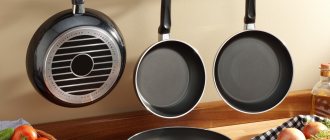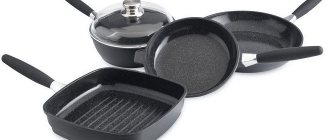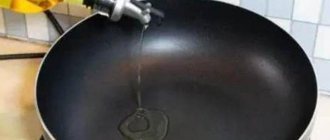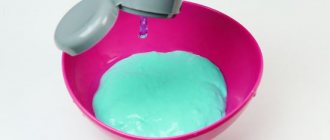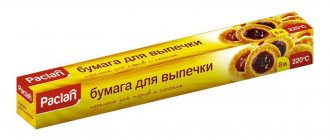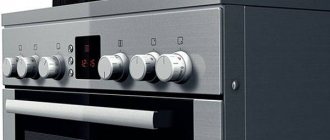People of the middle and older generations often ask themselves the question why their grandmother’s old frying pans served for decades, while today’s ones cannot even dream of such a period. Why does it often happen that even an old frying pan is much more convenient to use than a new one?
And it makes no difference - it’s a new cast iron, super-duper sophisticated, aluminum, with or without various “innovative” coatings. The answer lies on the surface - the quality of the product does not depend at all on the quality of advertising. And this is very often forgotten by many manufacturers; they too faithfully believe that “advertising is the engine of trade” and begin to forget about the quality of their goods.
In not so distant times, less attention was paid to advertising; advertising was considered almost a violation of socialist principles, with all the ensuing consequences, including accusations of admiration for Western values.
Advertising was done by the buyers themselves, using word of mouth. And “word of mouth” was turned on only when the product really deserved it and when its characteristics were confirmed by time. So it turned out that the old frying pans had excellent characteristics; entire generations cooked food on them, this is without any exaggeration.
Nowadays, finding an old cast-iron frying pan is very rare, but if you are lucky, be sure to take the chance and give it a “new life,” especially since it is not at all difficult. But after that, it will serve your family faithfully for many years to come.
Can I use the frying pan if I remove the non-stick coating?
Violation of the integrity of the outer coating of the frying pan leads to a decrease in its non-stick properties: during cooking, food sticks to the bottom and burns. But this is not the biggest problem.
Damage to the Teflon coating, which contains perfluorooctanoic acid, is especially dangerous. When cracks and chips appear on the surface of the frying pan, it penetrates into the food, enters the human body with it and is not removed from there for a long time. Toxic substances have a negative impact on the functioning of various organs, primarily the liver and thyroid gland.
There is an opinion that frying pans with natural coatings - granite, marble, diamond, titanium, metal - are completely safe for health and can be used even if the surface layer is damaged. This statement is only partly true.
Firstly , the same granite and marble coating is based on the same tetrafluoroethylene.
Secondly , even if the coating itself is natural and environmentally friendly, like ceramic, if it is damaged, the unoxidized metal from which the dishes are made is exposed. When heated, it will react with foods, giving them a distinctive flavor.
Removing the non-stick layer completely, if it is already damaged, seems like a way out of this situation. On the forums you can find many tips on how to remove Teflon from a frying pan using sandpaper, a metal sponge, and even a drill. However, it is impossible to completely remove it from the surface of dishes at home. Tiny particles will still remain. Therefore, it is still recommended to replace the damaged frying pan with a new one.
Modern ways to bring old frying pans back to life
The problem with old cast iron frying pans is a large amount of soot and the appearance of rust. The most difficult thing is to remove the carbon deposits. This is not only difficult, but also a very long process. Try using a special aerosol to remove carbon deposits from gas ovens. Spray the pan and seal it tightly in a plastic bag.
Repeat the procedure every day (preferably twice a day) until the carbon deposits are washed off. How long it will take depends on your diligence, luck, the age of the pan and the amount of soot. But in any case, don’t expect a quick victory. After the carbon deposits have been removed, wash it well to remove any remaining chemicals, calcinate it well, pour a little sunflower oil on the bottom, and enjoy it to your health.
Along with the carbon deposits, the rust will also be washed off. Don’t worry about this, don’t take into account the various advice from “blondes” who only saw the frying pan in their mother’s hands. Nowadays you can find so many, to put it mildly, exotic advice (written, of course, by these same blondes) that your head is spinning.
I recently read some advice on how to carry out the first calcination of a cast iron frying pan - God bless! This anonymous person advised heating a cast iron frying pan in the oven, just think about it, up to +550°C!!! Then take it out from there and rub it with a napkin soaked in olive (always olive) oil!!! I can’t give a link to this “smart” site, it will be considered advertising.
The hair on my head is moving from such advice. The girl confused the oven with a blast furnace, and I can no longer imagine the process of rubbing a frying pan heated to +550°C with a napkin with olive oil (I wonder, first cold press or maybe a second press?) I can no longer imagine, either it’s scary, or it’s just not imaginative as developed as that of this “experienced” adviser.
Is it possible to restore the non-stick coating on a frying pan at home?
Another obvious solution to the problem is to try to apply a new non-stick coating yourself to replace the damaged one.
You must understand that it is simply impossible to do this efficiently at home. Applying a non-stick layer is a complex process. A composition consisting of several components is applied to the prepared surface. This is often done under high pressure. Then you need to wait for the layer to dry. Drying does not take place at room temperature, but in special chambers. Finding materials and following the technology for applying a non-stick layer at home is unrealistic.
If you wish, you can contact companies that specialize in restoring damaged non-stick coatings. But often it will be cheaper to buy a new frying pan than to repair an old one.
Therefore, if scratches, chips appear on the non-stick layer, and food begins to burn, it is better to seriously think about buying a new frying pan. And in order to extend its service life, you must follow all the manufacturer’s recommendations for its operation.
How to turn kitchen utensils into stylish decorative accessories
Don't rush to part with unnecessary dishes. From the remnants of your favorite tea set, a beautiful lid from a broken sugar bowl, spoons and forks that lie idle, you can get exclusive decorative items for your home or summer cottage.
A fountain made from a rusty vintage teapot and a wooden barrel is not an easy idea to implement, but it looks very impressive.
Not everyone can replicate a fruit dish made from old cutlery either. Although all you need is a mountain of unnecessary spoons, forks and knives, superglue and strong fingers to bend metal. Of course, no one forbids using pliers.
You can simply attach curved spoons and forks to a rectangular multi-colored piece of wood that is attached to the wall as decoration. So you have a hanger or pendant for keys.
Those who know how to use a drill can do the experiment with their old kettle. What if you also manage to get him to give your home such lacy lighting?
A chandelier made of knives and forks may appeal only to thrill-seekers. Bizarre shadows on the wall and metallic tinkling from the slightest movement or draft... Gothic and exotic.
But a chandelier made of only spoons does not look intimidating, but romantic. Real metal flowers. Snowdrops or tulips.
A lonely elderly ladle on the wall will not be so gloomy if you introduce it to a beautiful candle. Isn't it true that it turned out to be an interesting candlestick?
An old sieve or round iron cookie boxes nailed to the wall will make an equally interesting holder for small round candles.
An unnecessary grater will do for storing jewelry. How many earrings can you hook on?! For elegance, you can attach intricate legs to the grater. Surely, men will also find something that can be stored this way.
An ordinary glass jar will make a cute storage for a sewing kit, and a cup will make a cute pincushion.
A few plates that have been collecting dust in the closet for a long time as unnecessary will do the job of a mini-fence for your flowerbed.
Use unnecessary plates to make an interesting bird feeder.
And if cups and saucers are placed on twigs, they will turn into birdbaths.
Decorating walls with beautiful plates is not a new idea. But even here you can use your imagination.
Old lids from a sugar bowl and a teapot will become a convenient holder for all the necessary little things in the kitchen - scissors, pencils, towels.
If you attach the remains of the tea set to the finished shelf with glue, you will get a strange, but quite functional hanger.
Old enamel mugs also look beautiful as storage units for small items. For country decor - just right.
An ordinary tea cup is a godsend for home-grown interior designers. A curtain holder, a container for storing jewelry, a Christmas tree toy - all this can be made from an ordinary cup.
Place several cups upside down on slightly larger saucers - that's a pile for sweets.
Nowadays, many people are interested in making their own scented candles. So why buy special molds if you can make candles in cups that no one drinks coffee from anymore?
It is ideal when the color of the wax or stearin is in harmony with the color scheme of the cup.
If you attach cups, a saucer and a milk jug to the candlestick, you will get a whole set of everything you need for a romantic tea party.
A colander as a lampshade is, at least, not trivial.
But using cups instead of lampshades, you can make unique lamps that will add a special flavor to the interior of the kitchen or dining room.
A cup can be turned into a night light if you attach a beautiful transparent cup to the fittings of the simplest lamp.
Cup-lampshades in the wall are a very stylish and unusual decoration for the kitchen.
From the remnants of the service you can build the base of a floor lamp. To do this, you just need to drill holes in all the base elements and connect them with ceramic glue.
The remains of tea sets or individual cups (it’s okay, even if they are of different sizes) can easily be turned into a spectacular chandelier.
The variety of possible tableware chandeliers is limited only by your imagination.
A chandelier made of plates laid out in such a shape is a stylish piece of furniture.
Compositions of plants in disused dishes are now a fashionable decoration for a coffee, coffee or dining table, bedside table or chest of drawers.
Unnecessary dishes can be easily turned into an original flowerpot.
Do not throw away a teapot whose lid has broken; it will come out as an original flowerpot.
A resourceful housewife uses any old dishes in her garden design.
Even an old rusty grill becomes a nice flower bed.
Beds or flower beds can be decorated directly on the wall if you plant the plants in transparent jars.
And in the most ordinary white glass bottles with a high neck, plants look great. To do this, the bottles need to be attached to the wall with metal holders. If you choose tightening clamps as fastenings, you can remove the bottles and wash them.
Dwarf succulents (plants that retain moisture for a long time) are planted in mini-pots made from wine corks with magnets. By the way, do not forget to occasionally water such vegetation with a teaspoon.
If you place a garland in an empty bottle, leaving the fork outside, you will get a simple decoration for a romantic evening or for celebrating the New Year.
By the way, you can use egg cartons to store glass Christmas toys.
It turns out that broken dishes in the house are not only fortunate, but also beautiful. Shards of broken dishes are used for mosaics, for example, table tops, chair seats. Surely no one will have such a unique thing.
The remains of beautiful dishes as tiles on the kitchen wall are an original solution.
There are people who spend years collecting the most beautiful cups and plates from friends and acquaintances in order to one day create such a masterpiece.
The dial and hands can be attached to anything. Therefore, a large old plate, an unnecessary frying pan, or a tea set will make a lovely watch.
One of the most creative ideas for using old household utensils is a mirror framed with assorted broken dishes and cutlery.
Even decorations are made from dishes. If large cups or bowls “successfully” break, sand the edges and wear the remains of the beautiful dishes now as jewelry.
Check out ideas on how to make garden lamps from scrap items and garden sculptures from tires. Our video will show you how to make original box beds. And in this FORUMHOUSE section you will find a lot of interesting solutions on how to decorate and diversify the interior of your home.
